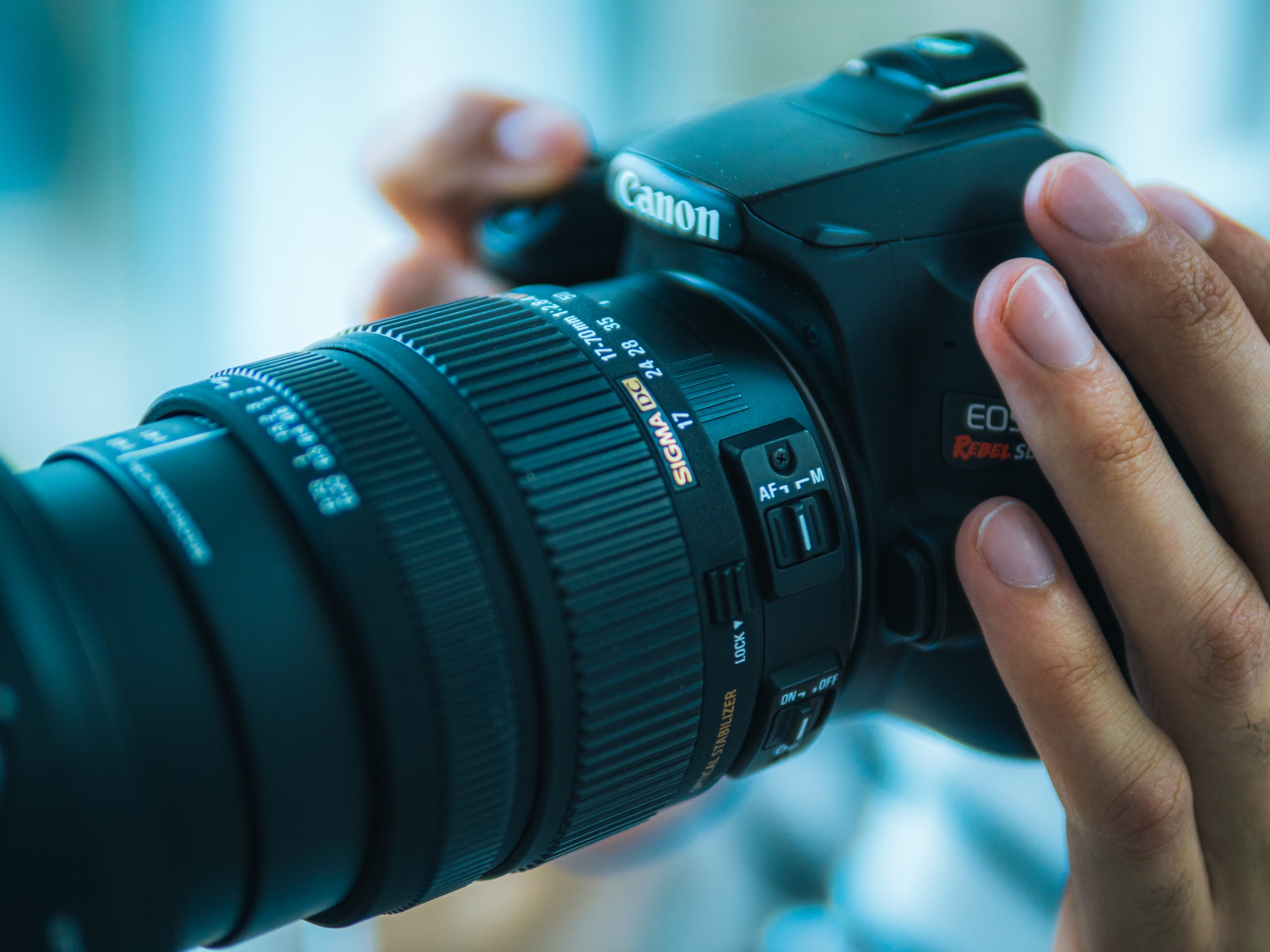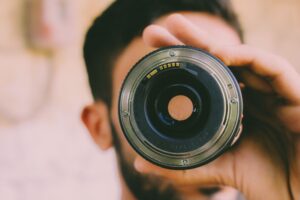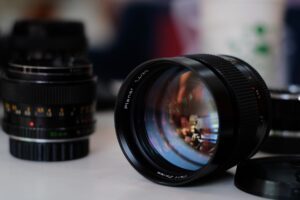How do camera lenses focus? The answer is simple: focus is all about directing light onto a photosensitive surface—like film or a sensor—to create a sharp image. Understanding focus is key to capturing clear and beautiful photos.
In this guide, we’ll dig into everything you need to know about focus, from the role of lenses to how autofocus systems work.
The Role of Lenses
First off, let’s talk about the role of lenses in how a camera focuses.
Lenses are not just chunks of glass or plastic; they are optical devices designed to bend and direct light.
When you point your camera at something, the lens takes in light from that object and directs it onto the camera’s photosensitive surface, either film or a digital sensor.
Lens Elements and Groups
A camera lens is not a single piece of glass but a complex assembly of multiple lens elements, often grouped together.
These elements serve various functions, from reducing distortions to enhancing image quality.
They work in harmony to control how light travels through the lens.
- Lens Elements: Individual glass or plastic components within the lens.
- Lens Groups: Clusters of lens elements that move together when you focus or zoom.
Understanding these elements and groups can help you make informed decisions when considering what camera lens you’ll need.
Why Bending Light is Necessary
Now, you might wonder, why does the lens need to bend light? The reason lies in the size of the photosensitive surface (film or sensor).
These surfaces are relatively small, so bending light helps concentrate the incoming rays onto this limited area. This is critical for achieving sharp and well-exposed images.
Fun Fact: The smaller the photosensitive surface, the more the lens has to bend light to cover it. This is why smartphone cameras have tiny lenses but still manage to capture decent photos.
Slowing Down and Directing Light
Lenses do more than just bend light; they also slow it down.
This ensures that the light hits the photosensitive surface at the right angles, contributing to the sharpness and clarity of the final image.
By adjusting the lens (either manually or through autofocus), you change how it directs light onto the film or sensor, affecting the overall focus of the image.
To sum up, the role of the lens in focus is multi-faceted:
- Bending Light: To direct it onto a small photosensitive surface.
- Slowing Down Light: To ensure it hits the surface at the right angles.
- Lens Elements and Groups: Work together to control light and improve image quality.
The Basics of Focus
Let’s face it, the science behind focus involves complex optics and physics. But don’t worry, we’re here to break it down and keep it as simple as possible.
Focus Through a Magnifying Glass
Remember those childhood days when you used a magnifying glass to focus sunlight and maybe, just maybe, tried to light a leaf on fire?
The magnifying glass bent and focused sunlight onto a tiny spot, concentrating its energy. Similarly, a camera lens focuses light but with far more precision and control.
Real-Life Example: Just like you adjusted the distance of the magnifying glass to find the sharpest point of light, a camera lens can be adjusted to focus light coming from different distances onto a photosensitive surface.
Light from Various Sources and Angles
When you’re photographing a scene, light doesn’t come from a single point; it comes from various sources and angles.
The camera lens takes all this light and focuses it onto the sensor or film. Each lens element plays a part in this, bending and redirecting light so that it converges at just the right spot.
The Need for Adjustable Focus
In photography, one size doesn’t fit all. Different scenes and subjects require different focus settings. That’s why adjustable focus is a godsend.
Most cameras handle this in two ways:
- Manual Focus: Here, you physically turn the lens or a focus ring to adjust the focus. This method gives you complete control but may require more time and skill.
- Autofocus: This is where the camera does the work for you, adjusting the lens based on complex calculations to quickly and accurately focus on your subject.
| Basics of Focus | Quick Summary |
|---|---|
| Adjustable Focus | Options include Manual and Autofocus |
| Light Source | Comes from various angles and distances |
| Convergence | Lens directs light to a single point on the sensor |
Understanding focus isn’t just for rocket scientists. It’s about knowing how your lens manipulates light to create those beautiful, sharp images.
And whether you’re going manual or relying on autofocus, there’s a method to suit your style.
Manual Focus vs. Autofocus
By now, you should have a basic understanding of what focus is and why it’s crucial in photography.
But when it comes to actually focusing your camera, you have two main options: Manual Focus and Autofocus. Let’s dive into each.
Manual Focus: The Art of Control
With manual focus, you are the artist, and the lens is your brush. This method involves physically turning the lens or a focus ring to adjust where the camera focuses.
The process can be slow and requires a bit of skill, especially if you’re a beginner. But the reward is complete control over the focal point in your image.
- Pros: Precise control, works well in low light, and can be better for macro or still-life photography.
- Cons: Can be slow, and there’s a learning curve.
If you’re keen on learning manual focus, particularly on your new camera, you might find our article on how to make the most of your kit lens useful.
Autofocus: The Technological Marvel
Enter the magic of autofocus. This is where technology takes the wheel, allowing the camera to automatically adjust the lens to focus on a subject.
Autofocus has come a long way since its inception, becoming faster, more reliable, and incredibly sophisticated.
- Pros: Quick, convenient, and usually accurate.
- Cons: May struggle in low-light conditions or with fast-moving subjects.
Understanding how autofocus works can also answer questions like “How do modern cameras focus?” or “Is autofocus in the lens or camera?” which many people often ask.
How Autofocus Systems Work
So, how does autofocus work its magic? In simple terms, these systems use electronic sensors to gauge the distance between the camera and the subject.
Based on this information, the camera adjusts the lens to achieve sharp focus.
These adjustments are made almost instantaneously, making autofocus incredibly efficient for most photography needs.
| Focus Method | Pros | Cons |
|---|---|---|
| Manual Focus | Precise control, good in low light | Slow, learning curve |
| Autofocus | Quick, convenient, usually accurate | May struggle in low light or with fast-moving subjects |
Both manual focus and autofocus have their own sets of advantages and limitations. Your choice between the two will largely depend on what you’re shooting and your personal preference.
If you’re a beginner, understanding both methods can significantly elevate your photography game.
Types of Autofocus: Active vs. Passive
You’ve gotten a taste of what autofocus can do, but did you know there are different types of autofocus systems? Yep, it’s not a one-size-fits-all deal.
The two main categories are Active Autofocus (Active AF) and Passive Autofocus (Passive AF). Let’s take a closer look.
Active Autofocus (Active AF)
Active AF systems are like tech-savvy detectives. They send out a signal—usually infrared light or sound waves—toward the subject.
When the signal bounces back, the system calculates the distance based on the time it took for the signal to return.
- Pros: Effective in low light or low-contrast situations.
- Cons: May be less accurate, and not all cameras support it.
Active AF is less common nowadays, but it’s still worth understanding its basics.
Passive Autofocus: The Star of the Show
Now, let’s turn our focus (pun intended!) to Passive AF systems, which are more commonly found in today’s cameras.
These systems don’t rely on emitted signals; instead, they use the light that enters through the lens to calculate focus.
The two main types are Phase Detection and Contrast Detection.
Phase Detection: The Quick Thinker
Phase Detection is like a juggler who keeps multiple balls in the air.
This system uses mirrors and prisms within the camera to split the incoming light into different phases. It then compares these phases to determine whether the image is in focus.
- How it Works: The system uses small mirrors and prisms to direct light toward phase-detection sensors. These sensors quickly analyze the light to adjust focus.
Contrast Detection: The Detail Oriented
Contrast Detection is the meticulous one in the family.
It evaluates the changes in light intensity between adjacent pixels on the sensor. The greater the contrast, the more “in focus” the image is.
- How it Works: The system continuously scans the sensor, measuring contrast levels. When it detects maximum contrast, it locks the focus.
| Type of Autofocus | How It Works | Pros & Cons |
|---|---|---|
| Active AF | Sends out signals to measure distance | Effective in low light, may be less accurate |
| Phase Detection | Uses mirrors and prisms to analyze light | Quick, but may struggle with low contrast |
| Contrast Detection | Evaluates changes in light intensity | Detailed, but can be slower |
You might find yourself asking questions like “Which is a disadvantage of autofocus?” or “When should you not use autofocus?” Knowing how these systems operate will help you answer these questions and more.
Advantages and Limitations
By now, you’ve been introduced to the wonderful world of focusing and the different types of autofocus systems. But as with any technology, there are pros and cons.
Let’s dive into some of the advantages and limitations of these autofocus methods.
Advantages: The Bright Side
One significant advantage of Contrast Detection is its flexibility in the number of focus points.
Unlike Phase Detection, which has predetermined focus points, Contrast Detection can evaluate focus almost anywhere within the frame. This makes it incredibly versatile, especially for complex compositions or off-center subjects.
Tip: If you’re into portrait photography or any genre requiring selective focus, the flexibility of Contrast Detection can be a real boon.
Limitations: The Challenges
Now, let’s talk limitations.
For one, Contrast Detection requires constant image evaluation, which can consume more power and potentially slow down the focusing speed.
This might not be a big deal for still photography but can be a challenge for capturing fast-moving subjects or shooting video.
Tech to the Rescue: Mitigating Limitations
Technology never stands still, and autofocus systems are no exception.
Newer cameras often combine Phase and Contrast Detection to create Hybrid Autofocus Systems. These systems aim to offer the speed of Phase Detection and the accuracy of Contrast Detection, mitigating the limitations of each.
- Software Updates: Some cameras allow for firmware updates that can improve autofocus performance.
- AI and Machine Learning: Emerging technologies are making autofocus smarter, quicker, and more reliable.
| Advantages & Limitations | Detail |
|---|---|
| Advantage | Flexibility in the number of focus points in Contrast Detection |
| Limitation | Need for constant image evaluation in Contrast Detection |
| Technology Improvement | Hybrid Autofocus Systems, Software Updates, AI |
While autofocus systems come with their own sets of challenges, ongoing advancements in technology are continually pushing the boundaries, offering better performance and more flexibility.
For those keen on taking their photography skills to the next level, our article on zoom lenses vs. prime lenses offers an excellent perspective on lens choices that can impact focus.
FAQs
How Do Cameras Determine the Focus Point?
Cameras use autofocus systems to identify what to focus on. These systems evaluate various parameters like distance, contrast, and sometimes even use machine learning algorithms to determine the subject.
What Makes Eye Focus Different from Camera Focus?
Eyes and cameras focus differently due to biological versus mechanical factors. Eyes adjust the shape of their lenses, while cameras move their lenses forward and backward to achieve focus.
Why Do Smartphone Cameras Seem to Keep Everything Focused?
Smartphone cameras often have a smaller sensor and a wide depth of field, making it easier to keep multiple elements in focus. Some also use computational photography techniques to enhance focus.
Which Aperture Setting Will Keep Everything in Focus?
A smaller aperture, represented by a larger f-number (e.g., f/16 or f/22), will create a wider depth of field, keeping more elements in focus. However, this may require slower shutter speeds or higher ISO settings.
When Is It Not Advisable to Use Autofocus?
Autofocus may not be ideal in low light, fast-moving subjects, or scenes requiring precise focus control. In such cases, manual focus might yield better results.
Why Might a Camera Fail to Focus?
Several factors can cause a camera not to focus, including low light, lack of contrast, or obstructions between the camera and the subject. Sometimes, lens or sensor issues could be the culprit.
How Does a Camera Adjust Focus for Varying Distances?
Cameras adjust focus by moving lens elements forward or backward. In autofocus systems, electronic sensors gauge the distance between the camera and the subject to adjust the lens accordingly.
Conclusion
We’ve covered a lot of ground in this ultimate guide on how focus works in photography. From the role of lenses to the intricacies of manual and autofocus systems, there’s a lot to digest.
Let’s quickly recap the key takeaways:
- The Role of Lenses: Lenses bend and direct light onto a photosensitive surface, such as film or a digital sensor. They comprise multiple elements and groups, each serving a specific function.
- Basics of Focus: Whether manual or autofocus, the principle remains the same: direct light to create a sharp image. You have control in manual focus, while autofocus offers speed and convenience.
- Types of Autofocus: Active and Passive Autofocus Systems have their own sets of pros and cons. Passive systems like Phase and Contrast Detection are more commonly used today.
- Advantages and Limitations: While autofocus systems are incredibly versatile, they do have limitations, such as the need for constant image evaluation in Contrast Detection. However, technological advancements are helping to mitigate these issues.
And there you have it! Understanding how camera lenses focus is your gateway to achieving sharp, focused, and simply captivating images.
We hope this guide has been helpful and encourages you to keep exploring the fascinating world of photography



![Read more about the article Lens Care 101: How Do You Clean a Camera Lens? [2023]](https://photographyexplorer.com/wp-content/uploads/2023/08/How-Do-You-Clean-a-Camera-Lens-300x200.jpg)

![Read more about the article Should I Buy Used Camera Lenses? Insights, Advice & Recommendations [2023]](https://photographyexplorer.com/wp-content/uploads/2023/08/Should-I-Buy-Used-Camera-Lenses-300x200.jpg)

![Read more about the article How to Store Camera Lenses Properly for Longevity and Performance [2023]](https://photographyexplorer.com/wp-content/uploads/2023/08/How-to-Store-Camera-Lenses-Properly-300x200.jpg)
